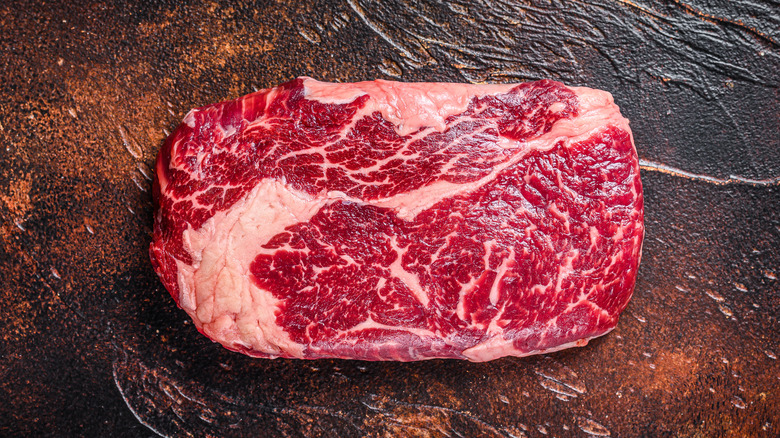Shooter's Sandwiches Are A Portable Twist On Beef Wellington
If you're a fan of British food, you're likely familiar with the UK's beloved beef Wellington. This luxe, savory dish is often synonymous with high-end restaurants and celebrations, thanks to its expensive beef tenderloin center and often elaborately decorated puff pastry shell. However, there is a humbler spin on a classic beef Wellington that's taking over kitchen counters and being shown off on DIY blog posts rather than being showcased at white-tablecloth establishments. And no, we're not talking about corner store Cornish pasties or flaky British sausage rolls, although they may hit the spot as well.
Shooter's sandwiches feature many of the same ingredients as a beef Wellington, but this sandwich is sculpted into a smaller steak-filled dish that is ideal for packing inside a picnic basket or eating one-handed on a road trip. While obviously less decadent than a real beef Wellington, and stuffed with cheaper ingredients, this sandwich will fill you up on the go, a perk few would contest. These features may make this dish seem like a modern invention made for convenience, but the shooter's sandwich actually dates back to Britain's Edwardian era.
History of shooter's sandwiches
You may be wondering how this twist on a beef Wellington got a name so distant from its original inspiration. In the early twentieth century, the British elite of the time often found these sandwiches packed inside their lunch bags for long days spent hunting and shooting, thanks to one creative cook. Legend has it that the inventor of the sandwich was a chef for a wealthy family who was tasked with making an easy-to-eat, portable lunch that was to be brought on a hunting excursion the following day. Direct inspiration was taken from beef Wellington, and the hunters ended up loving this filling sandwich.
The shooter's sandwich regained popularity in the most recent decades when a 2010 Guardian article by Tim Hayward brought long-lost attention to this one-of-a-kind creation. It detailed how to properly concoct this "world's best sandwich" along with all the tasty ingredients stuffed inside.
Ingredients in shooter's sandwiches
A beef Wellington often features a lengthy beef tenderloin in the center of the dish, but opting for a ribeye steak is a more convenient fit for this sandwich. Other similar cuts of steak work too. The main thing to keep in mind when selecting a steak is that it is roughly the same size as the bread you'll be using. Instead of puff pastry, shooter's sandwiches are made from large bread loaves. A thick, crusty loaf is perfect for this kind of sandwich. Between the crumbly bread layers and juicy meat, condiments like mustard and horseradish get slathered among the sautéed mushrooms, shallots, and other optional spices and seasonings. The final result is a substantial sandwich made to satisfy.
There's good news if you're not a fan of the meaty, savory, and heavy ingredients traditionally stuffed inside this classic sandwich. This meal is quite versatile, and you can select virtually any ingredients you prefer to make your own version of a shooter-style sandwich. What really makes an authentic shooter's sandwich is less about the ingredients and more about the method used to make it.
How shooter's sandwiches are made and eaten
While this sandwich is suitable to enjoy on the go, creating it involves a laborious two-day process. After gathering your ingredients, an easy first step is to create the mushroom filling. The mixture requires the mushrooms to be very finely diced, sautéed, and seasoned. Once cooked, chopped shallots can get tossed in as well. The mixture will become golden brown and crispy, and can then be set aside while other tasks get checked off the list. Slice off the top of the large loaf of bread used for the dish and remove the fluffy insides. Once hollowed out, spread sauce inside the bread, press in the mushroom mixture, and a place a seared steak on top. Add another layer of mushroom above the steak, then place the original "lid" of bread back on.
The initial assembly can be done quickly, but the following step takes several hours. The sandwich needs to be wrapped before it gets pressed down; anything from parchment paper to cling wrap works fine. Typically an additional layer of aluminum foil is also placed over the sandwich. Once enclosed, a flat surface, such as a sheet pan, is placed on top of the sandwich and weighed down with a heavy object. The next morning, you should find your flattened meal firmly pressed into a dense sandwich. It's ready to be unwrapped and sliced into, so you can finally enjoy your Edwardian-era dish made for 21st century convenience.



